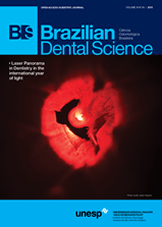Diagnostic reliability of a simplified epidemiologic tool to detect high-risk overjet for dental trauma.
DOI:
https://doi.org/10.14295/bds.2015.v18i4.1167Abstract
Objective: To evaluate the diagnostic reliability of a simplified tool to detect high-risk overjet for dental trauma. Material and Methods: The study population was composed of 131 volunteers divided into two groups according to the overjet measurement in terms of risk for traumatic dental injury (GRAB: risk absent and GRPR: risk present). The distance between the most prominent labial surface and its corresponding counterpart was measured using both the conventional (WHO, 1997) and the simplified tool. The measurements were taken independently and on separate occasions by two previously calibrated dental surgeons (Kappa=0.86). The gold standard method, as recommended by the WHO (1997), was performed by an external examiner. The simplified method, based on pencil-marked wooden tongue depressors was carried out in a blind manner by the other examiner. Sensitivity, specificity, positive and negative predictive values were calculated for the classification of risk for dental trauma in terms of overjet using the simplified method and compared to the conventional method. Results: The results revealed high values for sensitivity (S=1), specificity (E=0.93), positive (PPV=0.95) and negative predictive value (NPV=1). Conclusion: The examination using the simplified tool was reliable in identifying high-risk overjet, thus offering an alternative to the conventional examination.Downloads
Downloads
Published
How to Cite
Issue
Section
License
Brazilian Dental Science uses the Creative Commons (CC-BY 4.0) license, thus preserving the integrity of articles in an open access environment. The journal allows the author to retain publishing rights without restrictions.
=================




























